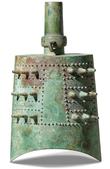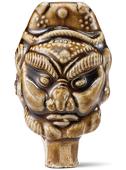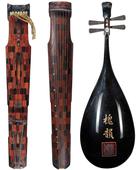 A bronze ritual bell from Western Zhou Dynasty was the oldest item at the Bonham’s Hong Kong auction. (PHOTO PROVIDED TO CHINA DAILY)
A bronze ritual bell from Western Zhou Dynasty was the oldest item at the Bonham’s Hong Kong auction. (PHOTO PROVIDED TO CHINA DAILY)
Earlier this month, Bonhams Hong Kong hosted an auction dedicated to music in Chinese art, a first-ever in the city and possibly the world. Titled “Eternal Resonance: Music in Chinese Art”, the show featured items from the Bronze age to the present day and included musical instruments and music-themed objects used for ritual, spiritual, social or leisure purposes. Also included were antiques bearing images of musical instruments being played.
Bonhams Hong Kong’s specialist on Chinese works of art, Keason Tang, says the relatively low commercial value of Chinese musical instruments and the lack of public education could be the reasons why musical instruments do not make it to auctions that often. Very few exhibitions of Chinese musical instruments have been held in museums around the world. Tang found no record of museum exhibitions or auctions dedicated to Chinese music held in China.
“I don’t know why there are not many exhibitions or even talks featuring Chinese music in China, including Hong Kong,” says Tang. “Auction houses are driven by commercial value so there’s no surprise there. In our auction, the most expensive lots were the guqins (bowed string instrument), bells and instruments that are valued for the materials.”
 Green-glazed “figural” whistle from Song Dynasty, possibly depicting a foreigner. (PHOTO PROVIDED TO CHINA DAILY)
Green-glazed “figural” whistle from Song Dynasty, possibly depicting a foreigner. (PHOTO PROVIDED TO CHINA DAILY)
Although Bonhams didn’t share a post-sales report for this auction, the top three lots to be snapped up were all guqins, valued at a combined total of over HK$11 million (US$1.42 million). Tang says the buyers could have been collectors of lacquer art.
The most expensive of the trio, sold for HK$5 million, is a Ming Dynasty (1368—1644 CE) taigu yuanyin made from a combination of warm and dark woods like zitan, huanghuali (Chinese rosewood) and hongmu. The hexagonal patchwork on its body mimics Buddhist vestments, and the top is adorned with mother-of-pearl studs and tasselled jade pegs.
Almost all of the instruments on show were still in working condition. The oldest item in the lot, for instance, was a large archaic bronze ritual bell that dates back to the Early Western Zhou Dynasty (1045 – 771 BC). It was a part of a set that probably belonged to royalty or an aristocrat.
 Confucius-style huanghuli and zitan inlaid 100-patch guqin from Ming Dynasty. Pear-shaped fine Nanyin “Huaiyun” pipa (left) from Qin Dynasty, used to play southern music. (PHOTO PROVIDED TO CHINA DAILY)
Confucius-style huanghuli and zitan inlaid 100-patch guqin from Ming Dynasty. Pear-shaped fine Nanyin “Huaiyun” pipa (left) from Qin Dynasty, used to play southern music. (PHOTO PROVIDED TO CHINA DAILY)
A green-glazed “figural” whistle from the Song Dynasty (960 – 1278 CE) or earlier, was also on offer. Tang says the whistle, shaped in the form of a bearded foreigner’s face with high cheekbones and furrowed brows, attracted a lot of notice.
The pear-shaped fine Nanyin “Huaiyun” pipa from Qin Dynasty (1644 – 1912 AD), on the other hand, is regarded for its excellent condition. A Chinese lute mainly used to play southern music, this instrument was crafted out of black-lacquered fir wood, cedar and wutong, which Tang says are extremely difficult to preserve.
Setting prices was a challenge, especially when it came to rare instruments. The starting bid was set quite low to drive engagement, says Tang.
“This is our first time doing this so we wanted the show to be interesting so that more people engage and participate,” he says.


